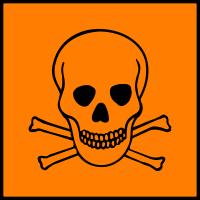|
Storage Warning
|
|
Highly Flammable/Corrosive/Harmful/Irritant/Hygroscopic/Keep Cold/Store under Argon
|
 Show
data source Show
data source
|
|
Hygroscopic
|
 Show
data source Show
data source
|
|
|
European Hazard Symbols
|
 Corrosive (C) Corrosive (C)
|
 Show
data source Show
data source
|
 Flammable (F) Flammable (F)
|
 Show
data source Show
data source
|
 Toxic (T) Toxic (T)
|
 Show
data source Show
data source
|
|
X
|
 Show
data source Show
data source
|
|
|
UN Number
|
|
1759
|
 Show
data source Show
data source
|
|
1760
|
 Show
data source Show
data source
|
|
2924
|
 Show
data source Show
data source
|
|
UN2811
|
 Show
data source Show
data source
|
|
UN2922
|
 Show
data source Show
data source
|
|
UN2924
|
 Show
data source Show
data source
|
|
|
MSDS Link
|
|
|
German water hazard class
|
|
3
|
 Show
data source Show
data source
|
|
|
Hazard Class
|
|
3
|
 Show
data source Show
data source
|
|
6.1
|
 Show
data source Show
data source
|
|
8
|
 Show
data source Show
data source
|
|
|
Packing Group
|
|
1
|
 Show
data source Show
data source
|
|
2
|
 Show
data source Show
data source
|
|
II
|
 Show
data source Show
data source
|
|
|
Risk Statements
|
|
11-19-22-34
|
 Show
data source Show
data source
|
|
11-19-34-37
|
 Show
data source Show
data source
|
|
25-34
|
 Show
data source Show
data source
|
|
25-38-41
|
 Show
data source Show
data source
|
|
34
|
 Show
data source Show
data source
|
|
|
Safety Statements
|
|
16-26-36/37/39-45
|
 Show
data source Show
data source
|
|
20-23-26-36/37/39-45
|
 Show
data source Show
data source
|
|
26-27-36/37/39-45
|
 Show
data source Show
data source
|
|
26-36/37/39-45
|
 Show
data source Show
data source
|
|
9-16-26-33-36/37/39-45-60
|
 Show
data source Show
data source
|
|
|
TSCA Listed
|
|
是
|
 Show
data source Show
data source
|
|
|
GHS Pictograms
|

|
 Show
data source Show
data source
|

|
 Show
data source Show
data source
|

|
 Show
data source Show
data source
|

|
 Show
data source Show
data source
|

|
 Show
data source Show
data source
|
|
|
GHS Signal Word
|
|
Danger
|
 Show
data source Show
data source
|
|
|
GHS Hazard statements
|
|
H225-H314-H335
|
 Show
data source Show
data source
|
|
H225-H314-H351-H302-H335
|
 Show
data source Show
data source
|
|
H300-H314-H318
|
 Show
data source Show
data source
|
|
H300-H315-H318
|
 Show
data source Show
data source
|
|
H314
|
 Show
data source Show
data source
|
|
|
GHS Precautionary statements
|
|
P210-P241-P303+P361+P353-P305+P351+P338-P405-P501A
|
 Show
data source Show
data source
|
|
P210-P261-P280-P305 + P351 + P338-P310
|
 Show
data source Show
data source
|
|
P260-P301+P310-P303+P361+P353-P305+P351+P338-P405-P501A
|
 Show
data source Show
data source
|
|
P280-P301+P310-P305+P351+P338-P302+P352-P405-P501A
|
 Show
data source Show
data source
|
|
P280-P305 + P351 + P338-P310
|
 Show
data source Show
data source
|
|
|
Personal Protective Equipment
|
|
Eyeshields, Faceshields, full-face particle respirator type N100 (US), Gloves, respirator cartridge type N100 (US), type P1 (EN143) respirator filter, type P3 (EN 143) respirator cartridges
|
 Show
data source Show
data source
|
|
Faceshields, full-face respirator (US), Gloves, Goggles, multi-purpose combination respirator cartridge (US), type ABEK (EN14387) respirator filter
|
 Show
data source Show
data source
|
|
|
RID/ADR
|
|
UN 1759 8/PG 1
|
 Show
data source Show
data source
|
|
UN 1759 8/PG 2
|
 Show
data source Show
data source
|
|
UN 1760 8/PG 2
|
 Show
data source Show
data source
|
|
UN 2924 3/PG 2
|
 Show
data source Show
data source
|
|
|
Supplemental Hazard Statements
|
|
May form explosive peroxides.
|
 Show
data source Show
data source
|
|
|
Storage Temperature
|
|
2-8°C
|
 Show
data source Show
data source
|
|